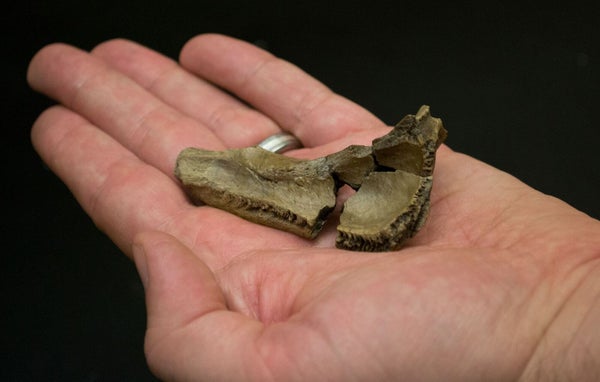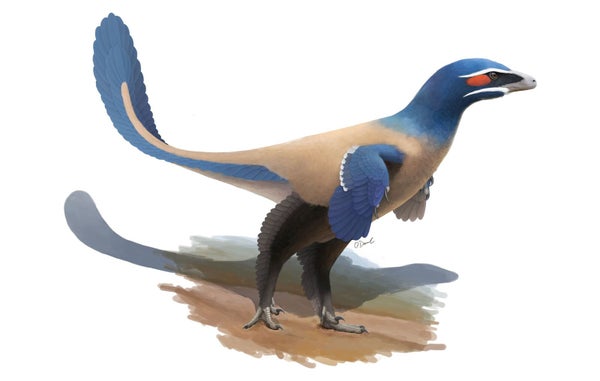This article was published in Scientific American’s former blog network and reflects the views of the author, not necessarily those of Scientific American
2017 could be called the Year of the Troodontid. Several of these small, fluffy dinosaurs have already been announced in the past 7 months. And while most have been uncovered in China, that's hardly the only place these sharp-clawed dinosaurs strutted around during their Cretaceous heyday. The latest of these raptor-like dinosaurs has just been described from Alberta, Canada.
The new dinosaur, named Albertavenator curriei by paleontologist David Evans and colleagues, was discovered among the 71 million year old rock of Alberta, Canada's Horseshoe Canyon Formation. As yet, not very much of the tiny carnivore is known. All that paleontologists have described so far are a duo of skull bones from two different individuals. But those fossils are still distinctive enough to say that Albertavenator is something new to science.
Both known bones are frontals - triangular bones from the top of the dinosaur's skull, bordering the opening for the eye. And when Evans and colleagues compared these specimens to the equivalent bones from other, related dinosaurs, they found that the Albertavenator frontals stood apart. The bones look squatter and more robust than their counterparts in animals like Troodon.
This might not seem like much to shout about, but the importance of any given dinosaur is relative. Despite being scoured for paleontologists for over a century, only one other troodontid skull bone - part of a lower jaw - has ever been found in the Horseshoe Canyon Formation. Not only does this mean that there's a dinosaur we never knew about in these rocks, but the mystery of who that jaw belonged to now carries more weight.
Did the enigmatic lower jaw bone really fit in the mouth of Troodon as experts previously proposed, Evans and colleagues wonder, or should it be assigned to Albertavenator? Better and more complete material is needed to be sure, but the question raises the possibility that these feathery dinosaurs had distinct crania but very similar jaws and teeth. If that's so, parsing who lived where by teeth alone suddenly becomes a much more fraught task. With any luck, the fossil record won't keep us waiting too long for an answer.

An Albertavenator skull bone. Credit: Kentaro Chiba
On supporting science journalism
If you're enjoying this article, consider supporting our award-winning journalism by subscribing. By purchasing a subscription you are helping to ensure the future of impactful stories about the discoveries and ideas shaping our world today.
Fossil Facts
Name: Albertavenator curriei
Meaning: Albertavenator means "Alberta hunter", while curriei honors paleontologist Phil Currie.
Age: Cretaceous, about 71 million years old.
Where in the world?: Alberta, Canada.
What sort of organism?: A troodontid dinosaur.
How much of the organism’s is known?: Two skull bones.
Reference:
Evans, D., Cullen, T., Larson, D., Rego, A. 2017. A new species of troodontid theropod (Dinosauria: Maniraptora) from the Horseshoe Canyon Formation (Maastrichtian) of Alberta, Canada. Canadian Journal of Earth Sciences. doi: 10.1139/cjes-2017-0034
Previous Paleo Profiles:
The Light-Footed Lizard The Maoming Cat Knight’s Egyptian Bat The La Luna Snake The Rio do Rasto Tooth Bob Weir's Otter Egypt's Canine Beast The Vastan Mine Tapir Pangu's Wing The Dawn Megamouth The Genga Lizard The Micro Lion The Mystery Titanosaur The Echo Hunter The Lo Hueco Titan The Three-Branched Cicada The Monster of Minden The Pig-Footed Bandicoot Hayden's Rattlesnake Demon The Evasive Ostrich Seer The Paradoxical Mega Shark The Tiny Beardogs The Armored Fish King North America's Pangolin The Invisible-Tusked Elephant The Mud Dragon The Spike-Toothed Salmon The Dream Coast Crocodile Buriol's Robber Ozimek's Flyer The Northern Naustoceratopsian The High Arctic Flyer The Tomatillo From the End of the World The Short-Faced Hyena The Mighty Traveler from Egg Mountain Keilhau's Ichthyosaur Mexico's Ancient Horned Face Mauricio Fernández's Plesiosaur New Zealand's Giant Dawn Penguin The Orange Sea Lion Mongolia's Ginkgo Cousin The Geni River Frog Isabel Berry's Dinosaur The Whale Caiman The Moab Lizard Yang Zhongjian's Lizard The Little Anubis The Shuangbai Lizard The Wyvern Dinosaur The "Need Helmet" Dinosaur The Jianianhua Dragon The Liaoning Hunter The Dalian Lizard Crompton's Aleodon Jenkins' Amphibian Serpent From the Chinle The Large Ancestor Lizard The Crown Tooth
